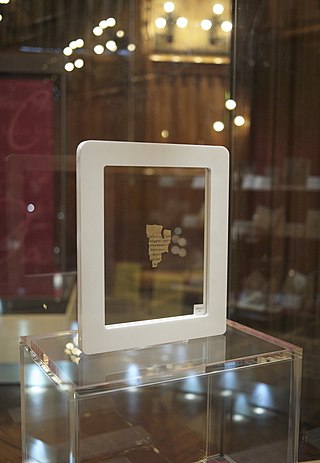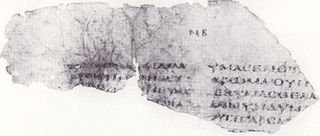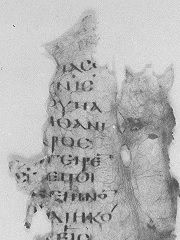Related Research Articles
Gospel originally meant the Christian message, but in the 2nd century it came to be used also for the books in which the message was reported. In this sense a gospel can be defined as a loose-knit, episodic narrative of the words and deeds of Jesus, culminating in his trial and death and concluding with various reports of his post-resurrection appearances. Modern biblical scholars are cautious of relying on the gospels uncritically, but nevertheless, they provide a good idea of the public career of Jesus, and critical study can attempt to distinguish the original ideas of Jesus from those of the later Christian authors.

The Gospel of Thomas is an extra-canonical sayings gospel. It was discovered near Nag Hammadi, Egypt, in December 1945 among a group of books known as the Nag Hammadi library. Scholars speculate that the works were buried in response to a letter from Bishop Athanasius declaring a strict canon of Christian scripture. Scholars have proposed dates of composition as early as 60 AD and as late as 250 AD. Since its discovery, many scholars have seen it as evidence in support of the existence of a "Q source" which might have been very similar in its form as a collection of sayings of Jesus without any accounts of his deeds or his life and death, referred to as a sayings gospel.

The Gospel of Peter, or the Gospel according to Peter, is an ancient text concerning Jesus Christ, only partially known today. It is considered a non-canonical gospel and was rejected as apocryphal by the Church's synods of Carthage and Rome, which established the New Testament canon. It was the first of the non-canonical gospels to be rediscovered, preserved in the dry sands of Egypt.

The Egerton Gospel refers to a collection of three papyrus fragments of a codex of a previously unknown gospel, found in Egypt and sold to the British Museum in 1934; the physical fragments are now dated to the very end of the 2nd century CE. Together they comprise one of the oldest surviving witnesses to any gospel, or any codex. The British Museum lost no time in publishing the text: acquired in the summer of 1934, it was in print in 1935. It is also called the Unknown Gospel, as no ancient source makes reference to it, in addition to being entirely unknown before its publication.

The Rylands Library Papyrus P52, also known as the St John's fragment and with an accession reference of Papyrus Rylands Greek 457, is a fragment from a papyrus codex, measuring only 3.5 by 2.5 inches at its widest, and conserved with the Rylands Papyri at the John Rylands University Library Manchester, UK. The front (recto) contains parts of seven lines from the Gospel of John 18:31–33, in Greek, and the back (verso) contains parts of seven lines from verses 37–38. Since 2007, the papyrus has been on permanent display in the library's Deansgate building.
A biblical manuscript is any handwritten copy of a portion of the text of the Bible. Biblical manuscripts vary in size from tiny scrolls containing individual verses of the Jewish scriptures to huge polyglot codices containing both the Hebrew Bible (Tanakh) and the New Testament, as well as extracanonical works.

Papyrus 45, designated by siglum 𝔓45 in the Gregory-Aland numbering of New Testament manuscripts, is an early Greek New Testament manuscript written on papyrus, and is one of the manuscripts comprising the Chester Beatty Papyri, a group of early Christian manuscripts discovered in the 1930s, and purchased by business man and philanthropist, Alfred Chester Beatty. Beatty purchased the manuscript in the 1930s from an Egyptian book dealer, and it was subsequently published in The Chester Beatty Biblical Papyri, Descriptions and Texts of Twelve Manuscripts on Papyrus of the Greek Bible by palaeographer, biblical and classical scholar Frederic G. Kenyon in 1933. Manuscripts among the Chester Beatty Papyri have had several places of discovery associated with them, the most likely being the Faiyum in Egypt. Using the study of comparative writing styles (palaeography), it has been dated to the early 3rd century CE. This therefore makes it the earliest example of not only the four Gospels contained in one volume, but also the Acts of the Apostles. It contains verses in fragmentary form from the texts of Matthew chapters 20–21 and 25–26; Mark chapters 4–9 and 11–12; Luke chapters 6–7 and 9–14; John chapters 4–5 and 10–11; and Acts chapters 4–17.
Uncial 0182, is a Greek uncial manuscript of the New Testament, dated paleographically to the 5th century.

Uncial 0183, is a Greek uncial manuscript of the New Testament, dated palaeographically to the 7th century.

Uncial 0184, is a Greek-Coptic diglot uncial manuscript of the New Testament, dated paleographically to the 6th century.

Uncial 0185, is a Greek uncial manuscript of the New Testament, dated palaeographically to the 4th-century.

Uncial 0213 is a Greek uncial manuscript of the New Testament, dated palaeographically to the 5th or 6th century.
Uncial 0214, is a Greek uncial manuscript of the New Testament, dated palaeographically to the 4th or 5th century.

Uncial 0217, is a Greek uncial manuscript of the New Testament, dated palaeographically to the 5th century.
Uncial 0218, is a Greek uncial manuscript of the New Testament, dated palaeographically to the 5th century.
Uncial 0237, ε 014, is a Greek-Coptic uncial manuscript of the New Testament. Paleographically it has been assigned to the 6th-century.
Lectionary 214, designated by siglum ℓ214, is a Greek manuscript of the New Testament, on parchment. Palaeographically it has been assigned to the 12th century. Scrivener labelled it by 239evl.

The Papyrus Fouad 266 are fragments, part of a papyrus manuscript in scroll form containing the Greek translation, known as the Septuagint, of the Pentateuch. They have been assigned palaeographically to the 1st century BCE. There is discussion about whether the text is original or a later recension of the Septuagint.

Papyrus Oxyrhynchus 655 is a papyrus fragment of the logia of Jesus written in Greek. It is one of the Oxyrhynchus Papyri discovered by Grenfell and Hunt between 1897 and 1904 in the Egyptian town of Oxyrhynchus. The fragment is dated to the early 3rd century. It is one of only three Greek manuscripts of the Gospel of Thomas.
References
- ↑ Bernhard, Andrew. Other Early Christian Gospels: A Critical Edition of the Surviving Greek Manuscripts. Library of New Testament Studies (315). London: T&T Clark, 2007. XIV-158 pages. ISBN 0-567-04568-4.
- ↑ J. K. Elliott. The Apocryphal New Testament: A Collection of Apocryphal Christian Literature in an English Translation. Oxford University Press, 2005, 774 pages. ISBN 0-19-826181-0 , ISBN 978-0-19-826181-0.
- ↑ Das Evangelium nach Petrus. Text, Kontexte, Intertexte. Edited by Thomas J. Kraus and Tobias Nicklas. (Texte und Untersuchungen zur Geschichte der altchristlichen Literatur. Archiv für die Ausgabe der Griechischen Christlichen Schiftsteller der ersten Jahrhunderte (TU), 158.) VIII-384 pages. Berlin–New York: Walter de Gruyter, 2007. ISBN 978-3-11-019313-8.
- ↑ Gospel Parallels, A Comparison of the Synoptic Gospels, 5th ed. Burton H. Throckmorton, Jr. editor. (Nashville: Thomas Nelson, 1992). ISBN 0-8407-7484-2